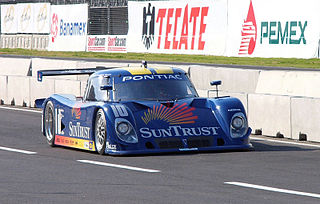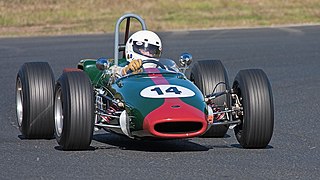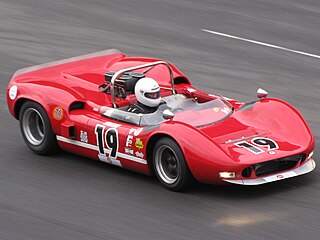
Formula Super Vee was an open-wheel racing series that took place in Europe and the United States from 1970 to 1990. The formula was created as an extension of Formula Vee, a racing class that was introduced in 1959. Formula Super Vee in Europe was similar to F3 or Formula Renault today, a stepping stone to F1. In the United States, Formula Super Vee, often referred to as Super Vee, was a natural progression to Indy Car and Can-Am. On both sides of the Atlantic the series also was a platform for the promotion of VW products, similar to how Formula Renault promotes Renault products today.

The Clubman is a class of prototype front-engined sports racing cars that originated in Britain in 1965 as a low-cost formula for open-top, front-engined roadgoing sports cars like the Lotus 7, which had been crowded out of the mainstream by rear-engined cars such as the Lotus 23.

Ray Mallock Ltd., also known as RML Group, is a motorsports and high performance engineering company, based in Wellingborough, Northamptonshire, United Kingdom.

The Ralt RT1 is a race car chassis produced by Ralt, and was the first modern car produced by the company. It saw widespread use in a number of different motorsports categories, mostly open-wheel racing, but later including sports car racing. It was powered by a number of different four-cylinder engines of about 1.6 L (98 cu in) in displacement, of different origin, including Hart, Cosworth, Toyota, and Volkswagen engines.

The Lotus 69 was an open-wheel formula racing car developed by Lotus in 1969 for use in Formula 2, Formula 3, and Formula Ford.

The Riley MkXI, and its evolutions and deriatives, the Riley MkXX, the Riley MkXXII, and the Riley MkXXVI, are a series of Daytona Prototype race cars, designed, developed and built by Riley Technologies, between 2003 and 2016. Between 2003 and 2016, the cars scored a combined total of 84 race wins, achieved 106 podium finishes, and clinched 85 pole positions.

The Brabham BT14 was an open-wheel mid-engined formula racing car, designed, developed and built by British manufacturer and constructor Brabham, in 1965. A total of 10 models were produced. It was specifically constructed to compete in Formula Libre racing. It competed in motor racing between 1965 and 1968; winning a total of 10 races, scoring 22 podium finishes, and clinching 4 pole positions. It also contested the 1967 European F2 Championship season, competitng in 7 races, but with no success; scoring no wins, pole positons, podium finishes, or scoring any points. It was powered by a naturally-aspirated 1.6 L (98 cu in) Ford twin-cam four-cylinder engine, which droves the rear wheels through a conventional 4-speed manual transmission.
Maserati has made three inline-4 racing engines, that were designed for both Formula One and Sports car racing. Their first engine was the supercharged 4CLT engine in 1950; with the 1.5 L engine configuration imposed by the FIA for engines with forced induction. Their second engine was the naturally-aspirated 250S engine; with the 2.5 L engine configuration, and was used by Cooper and JBW. Their third and final engine was the naturally-aspirated Tipo 6-1500; with the 1.5 L engine configuration, and the customer engine was used by Cooper, Emeryson, Lotus, and E.N.B. teams.

The Lola Mk1 is the first sports racing car made by Lola, under the leadership and guidance of Eric Broadley, in 1958. The body was designed and developed by chief stylist Maurice Gomm, made out of a steel or fiberglass tubular spaceframe chassis, covered in a low-profile, sleek, aluminum skin. The 80 hp (60 kW), 1,098 cc (67.0 cu in), Coventry Climax FWA four-cylinder engine was designed by Harry Mundy and Walter Hassan. The car used a 4-speed manual transmission, and was lightweight, only weighing in at a mere 812–840 lb (368–381 kg). It also notably won its class at the 1960 12 Hours of Sebring, being driven by Charles Vögele and Peter Ashdown. At least 32 cars were known to have been built, but the actual number is believed to be between 38 and 42.

The March 732 was a British open-wheel Formula 2 racing car, built by March Engineering and introduced in 1973. It was powered by the 2 L (120 cu in) BMW M12/7 engine. It's Formula Atlantic equivalent, the March 73B, was based on the 732

The Cooper-Bristol, formally called the Cooper Mk.I or the Cooper T20, is a Formula 2 racing car, built, designed, and developed by British manufacturer Cooper Cars in 1952.

The Cooper T23, formally called the Cooper Mk.II, is a Formula 2 racing car, built, designed, and developed by British manufacturer Cooper Cars in 1953. It also competed in Formula One, in 9 Grand Prix between 1953 and 1956. It was powered mainly powered by the 2-liter engine from Bristol, a six-cylinder, but also used a 2-liter Alta L-4 engine, which was used by Stirling Moss.

The Brabham BT30 was a open-wheel Formula 2 racing car used in the 1969, 1970, and 1971 European Formula Two Championship.

The Chevron B24 was a Formula 5000 racing car developed by Chevron Cars in 1972.

The Brabham BT15 is a mid-engined open-wheel Formula 3 racing car, designed, developed, and built by Brabham between 1965 and 1966. 26 cars were built. It was powered by a naturally aspirated, 997 cc (60.8 cu in), Ford straight-four engine ; which was popular with Formula Ford racing at the time.

The Brabham BT5, and its evolution, the Brabham BT8, are sports racing cars manufactured and developed by Brabham in 1963 (BT5) and 1964 (BT8), respectively. It won a total of 4 races, and achieved 10 podium finishes.

The McLaren M1A, and its derivatives, the McLaren M1B and the McLaren M1C, are a series of mid-engined Group 7 sports prototype race cars built by McLaren, between 1963 and 1968. The M1A was the team's first self-designed and developed sports car. Later versions, such as the 'M1B' and 'M1C', competed and raced in the North American Can-Am series, starting in 1966 season. The car was raced in North America and Europe in 1963 and 1964 in various Group 7 and United States Road Racing Championship series events. 24 examples of the M1A and M1B were built, and 25 examples of the M1C were manufactured. They were powered by a few different motors, including Chevrolet small-block engine, an Oldsmobile V8 engine, a Chevrolet big-block engine, and even a Ford FE engine. It was constructed out of a tubular space frame chassis, and, combined with its light weight of 551 kg (1,215 lb) this gave it a great power-to-weight ratio. The 4.5 L (270 cu in) Oldsmobile V8 engine developed around 310 hp (230 kW), while the 350 cu in (5.7 L) Chevrolet small-block V8 engine was capable of developing over 550 hp (410 kW), and 538 lb⋅ft (729 N⋅m) of torque. This drove the rear wheels through a Hewland L.G.400 four-speed manual transmission.

The Chevron B16 was a Group 4 sports prototype race car, designed, developed, and built in 1969 by the British racing car manufacturer Chevron Cars as a two-seater racing sports car for the makes world championship. Brian Redman won the very first outing, the 500 km (310 mi) race at the Nürburgring on September 7, 1969, at a time of 3:13:01.6 hours. The last victory with a Chevron B16 was achieved by Clemens Schickentanz on July 11, 1971, in the sports car race at the Norisring.

The Mallock U2 is a race car, originally designed, developed and built by Ray Mallock Ltd., in 1979. It was originally constructed to compete in a purpose-built front-engined sports prototype cars, called Clubman. It was versatile, as it also competed in Formula Junior, Formula Ford, and Formula Three events. The chassis was constructed out of a steel tubular spaceframe, and it was later equipped with a De Dion rear axle, in 1972. It was very light, weighing only 948 lb (430 kg). It was powered by a number of different four-cylinder engines; including an 1,172 cc (71.5 cu in) Ford Sidevalve engine, a smaller 997 cc (60.8 cu in) Ford Kent engine, an 1,100 cc (67 cu in) BMC A-series engine, and even a 1.5–1.6 L (92–98 cu in) Ford-Cosworth SCA/Cosworth FVA engine. This drove the rear wheels through a conventional 4-speed manual transmission; first used in the Austin A30.

The Dallara F308 is an open-wheel formula racing car, designed, developed and built by Italian manufacturer Dallara, for Formula Three racing categories, in 2008. It was used in different Formula Three racing categories and competitions between 2008 and 2011. It was later replaced and succeeded by the F312, in 2012.



















